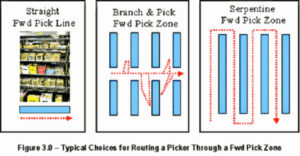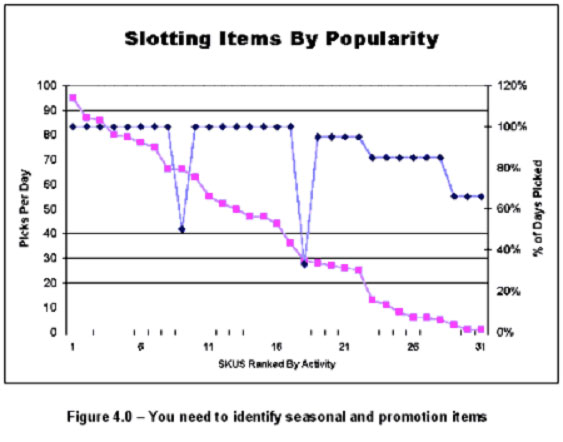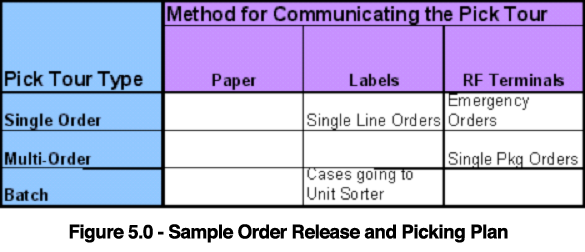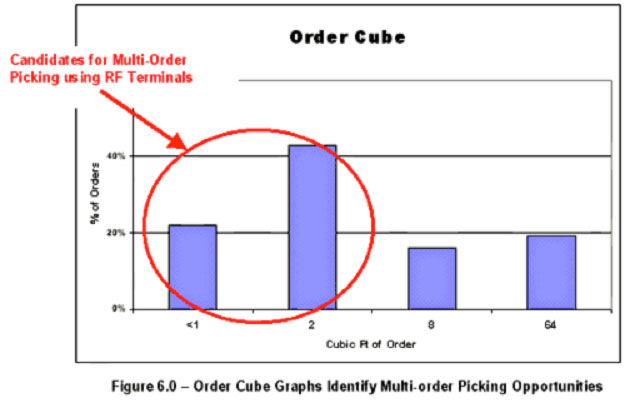A TACTICAL APPROACH: Slotting a Forward Pick Line
Three common methods for organizing and operating a forward pick area are: a straight pick line, a branch and pick zone, a serpentine pick zone. Each of these methods is shown graphically in figure 3.

It is quite simple (if there are no seasonal or promotional items in the group) to take item activity information from a warehouse management system or inventory control system and sort it in order of popularity. Using this information to rearrange SKUs on shelves or in flow rack, can significantly cut an operator’s walking distance and therefore, reduce cost. This is “Activity Profiling” in its simplest form.
If there are a number of promotional or seasonal items in your forward pick area, or you have introduced a number of new products, the analysis is a little more difficult. These items need to be isolated and decided on as to whether to include them in the “golden zone” within the forward pick area or not.
By graphing the % By graphing the percent of total days that each item is picked, it is easy to isolate the popular, seasonal or promotional items. Seasonal items tend to stick out like a sore thumb on these graphs. They will have high activity but the percent of days picked will be low. Seasonal/promotional items should be positioned towards the end of the line or not in the line when out of season.
A STRATEGIC APPROACH: Choosing a Picking Method for a Set of Orders
While Activity Profiling helps with many tactical improvements to your operations such as reslotting your forward pick area, even greater benefits can be achieved by using it as a tool to evaluate major changes to your operations.
Deciding on a method to release and pick your orders is an example of this type of analysis. Traditionally, most firms have picked orders using paper pick lists; however, many of the new warehouse management system applications allow users to pick orders in a variety of different ways such as batch, single-order, or multi-order. Furthermore, these systems support using labels, paper, or RF terminals to communicate such pick lists. Activity Profiling can help make the decision on how to pick within a zone much clearer and easier.
For example, it is helpful for a facility using a warehouse management system to develop a chart like the one in figure 5. Managers can then document how they would like certain types of orders processed in the facility. Using activity profiling results can make completing this chart easier. For example, you should graph lines per order as shown in figure 1. In most businesses, in order to get as many orders out the door as quickly as possible, all single line orders are selected, grouped together and picked by label.
While people in case pick facilities are usually aware of this opportunity, mangers of pick and pack operations often overlook other options such as batch label picking orders. Label picking is fast; pick the item, place it in a shipping container, apply the label, and put it on the conveyor or pallet going to shipping. This process bypasses the packing operation altogether.
If you have many multi-line orders, profiling the Order Cube information is helpful. The results of such an analysis are shown in figure 6. Notice that in this scenario, almost 60% of the orders require less than a shipping carton’s worth of material. If a large proportion of your orders are multi-line, consider multi-order picking those orders using carts with multiple slots, each slot dedicated to one order at a time. The same material handling concept can be applied to larger orders that are less than a shipping pallet’s worth of material. In this case a pull-train of pallets, each order having its own pallet, may be useful. Each of these approaches reduces the travel time spent picking orders in the facility.
Continued on page 3









